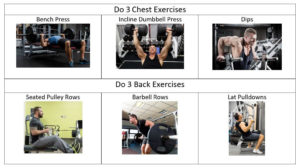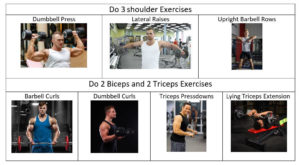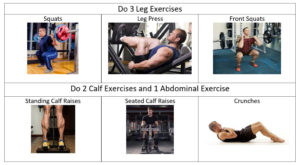Volume responsive hardgainers are rare but they exist. You could argue that a volume responsive hardgainer is not a true hardgainer; they seem like a hardgainer until they include enough training volume. Once they include enough training volume, their gains begin to accelerate. This is the opposite of what most people will experience with high volume training as the majority of lifters will stagnate or go backwards with a lot of training volume, especially hardgainers.
The last article was based on what I refer to as 12-10-8-6 training which is a training method that works well for those who respond well to a lot of training volume. Another type of training that can be used for those who respond well to training volume is the 8 sets of 8 reps workout for each exercise. Examples of this type of training will be discussed in this article which is taken from the second half of the eighth chapter of the book, Individualized Training Strategies For Hardgainers.
Chapter 8 Part 2
The 8 Sets of 8 Reps Workout
A second workout option that can be effective for the volume responsive hardgainer is to perform 8 sets of 8 reps for each exercise. The 8 sets of 8 reps workout is often done in the context of only doing one exercise for each muscle group, however, the volume responsive hardgainer can do two, or even three exercises for each muscle group when training chest, back, and leg muscles. When it comes to the smaller muscles of the arms and shoulders, you don’t need to do two or three exercises for each muscle group. I recommend that you only do one exercise for each muscle group when training biceps, triceps, and deltoids. The exercises shown below provide some options in terms of exercise choices for each muscle group.
1st Workout: Chest and Back on Monday and Thursaday
8 sets of 8 reps High Volume Routine
Exercise Selection
You can use the exercises shown below or substitute exercises of your choice for the given muscle group that you are training.
Order of Exercises
Do eight sets for chest followed by eight sets for back. Keep doing eight sets in a row for each muscle group and alternate back and forth between chest and back every eight sets.
2nd Workout: Shoulder and Arms on Tuesday and Friday
The 8 sets of 8 reps High Volume Routine
I would disregard the heading over the exercises that says to do three shoulder exercises and two biceps and triceps exercises as you can get by on just one exercise for these muscle groups as they are small and already receive a substantial amount of work from chest and back work.
Exercise Selection
You can use the exercises shown below or substitute exercises of your choice for the given muscle group that you are training.
3rd Workout: Legs and Abs on Wendesay and Saturday
The 8 sets of 8 reps High Volume Routine
Exercise Selection
You can use the exercises shown below or substitute exercises of your choice for the given muscle group that you are training.
Do 30 reps for each set of crunches for abs.
Rapid Training Pace
The 8 sets of 8 reps workout is traditionally done at a very rapid pace. This means as little as 15 seconds of rest between sets, and 45 seconds of rest at the most. The same weight should be used for all eight sets. Since a rapid pace is used, light weights must be used to complete eight reps on every set. If heavy weights were used, fatigue would quickly set in by the third set and you would no longer be able to keep on doing eight reps for the rest of the sets. To avoid this, the amount of weight used should be about 50% to 65% of the weight that you would use if you were just doing one hard set of eight reps.
Train With The Right Amount of Effort
If you choose to do the 8 sets of 8 reps workout, you should be able to maintain a steady even rep pace for every rep of every set. Normally the first three to four sets of 8 sets of 8 reps will feel pretty easy. However, the short rests between sets will cause fatigue to build up quickly and it will become much more challenging to do eight reps by the eighth set. Even so, the last set should not be so hard that you must struggle to squeeze out eight reps. You should still be able to maintain a steady even rep pace without feeling like your muscles are screaming with pain. If you push too hard, it will be difficult to do more than one exercise for each muscle group without overtraining.
I don’t recommend doing 8 sets of 8 reps on a permanent basis unless you find it to be especially effective. It is more likely that you will be able to do the 12-10-8-6 routine (listed in the previous article) on consistent basis as it provides both lighter weights and heavier weights, which I believe are necessary for maximum development. Do 8 sets of 8 reps as long as it works, but switch to the 12-10-8-6 routine if you start to burn out or stagnate on 8 sets of 8 reps.
Option: Do 4 x 8; Rest 3 Minutes; Repeat 4 x 8
You may find that doing eight consecutive sets at a rapid pace creates more fatigue than you would like. An alternative is to break up eight consecutive sets into two groups of 4 sets of 8 reps. You would do this by starting with 4 sets of 8 reps with 15 to 45 seconds of rest between sets. After the first four sets, rest at least 3 minutes and then do another 4 sets of 8 reps with short rests between sets. If you choose this option (and it is a very good option), you will be able to use about 10% to 15% more weight than if you did eight consecutive sets. During the time you are resting a muscle group for 3 to 5 minutes between groups of 4 sets of 8 reps, you also have the option of doing a group of 4 sets of 8 reps for a different exercise that works a different muscle group. This is like super setting back and forth between two muscle groups, but you will super set back and forth every four sets instead of every single set.
Summary of 8 sets of 8 reps
Chest, back, and legs should each be trained with two or three exercises.
Shoulders, biceps, triceps and calves should be trained with one exercise.
Do 8 sets of 8 reps for each exercise.
Train each muscle group two or three times per week using a split routine.
Select a weight that is 50% to 65% of the weight that you can use for one hard set of eight reps.
Rest only 15 to 45 seconds between sets.
Adjust the weight and rest time so that you can maintain a steady even rep pace for every rep of every set. Never grind or squeeze out slow reps at the end of your sets.
As an option, you can divide 8 sets of 8 reps into 2 groups of 4 sets of 8 reps with at least 3 minutes of rest between each group of 4 sets of 8 reps. You will be able to use about 10% to 15% more weight if you do this.
In the next article, I will be discussing a misinterpretation of the results that can occur when using high intensity or high volume training. Both forms of training can shock your body into rapid gains followed by a training rut. You must learn to think in terms of consistent small gains instead of a single burst of quick gains if you want to improve the most over the long term. Best of training to you.
Note:
Refer back to the previous six articles if you want to read the series of chapters from Individual Training Strategies For Hardgainers that are lead up articles to this article.
Hardgainers Part 1: Four Types
Hardgainers Part 2: Physiological Characteristics
Hardgainers Part 3: Conditional Hardgainers
Hardgainers Part 4: Intensity Responsive
Hardgainers Part 5: Volume Responsive




